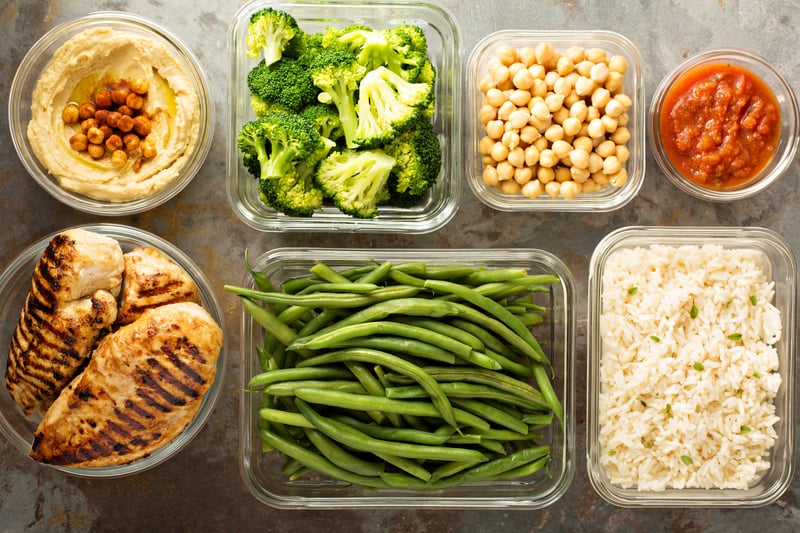How to Become a Meal Prep Master in 2022

Ever heard that weight loss is 80% nutrition and 20% exercise? It’s true. Getting to and maintaining a healthy weight and optimal health depends largely on what we put in our mouths. But it’s not always easy to stay on track, especially for those who are juggling multiple priorities. Yet taking precious weekend time to prep all your meals can feel like such a sacrifice too.
Still, for people who lose hours a week due to having to run to the grocery store multiple times to pick up forgotten items, waiting in line at a busy drive-in, or skipping meals only to watch energy levels and productivity crash in the middle of the day, setting up a meal-prep system can be well worth the effort. Plus, research has confirmed that meal planning and prep can help people eat healthier, as more varied diets can decrease the risk of obesity. 1
Fortunately, meal prep can not only save time during the week, but it doesn’t have to steal away from your limited free time either. You don’t even have to meal prep on the weekends. Some folks use batch cooking, meal-prep Mondays, or just creating a repeatable plan to make meal prep a bit easier on busy nights. Others invest a few hours on the weekend so meals can be set on autopilot during the week.
I admit, I’m nowhere near a meal-prep master, but I have found some great strategies to help me improve year after year, and they have helped shave hours from the time I spend in the kitchen (or just saying forget it and grabbing takeout).
Ready to join me in better learning how to master the meal plan? Let’s get started…
How to Be a Meal Prep Master: 10 Steps
1. Start with a Plan
The first tool you’ll need for mastering meal prep is a notebook, spreadsheet, or notes on your phone. Write down your ideas for meals, the list of ingredients that are already in your pantry, as well as those you’ll need to buy, and what components of the meal can be made early or repurposed throughout the week for multiple meals.
Jot down if, for example, you’ll be using chicken, brown rice, or sweet potatoes more than once in your meal plan, so you can batch cook them all at once.
You don’t have to make every meal for the week ahead of time (though you can if you want). But starting with a plan and preparing for the most challenging days of the week can save you time, energy, and stress. Just remember to take your list with you to the farmers’ market or grocery store.
2. Choose Once
If you find yourself getting bogged down in the planning stages of meal prep, this one tip can save you hours every month. What do we mean by choosing once? Simple, make the decision for multiple meals, set it, and repeat.
For example, to make breakfast more streamlined, choose one or two menu items that you’ll repeat and batch them all together. If, for instance, overnight oats are a favorite option, make up enough for several days. Or, make up some simple egg bites or protein pancakes or waffles you can heat up or toast throughout the week. Then batch cook them all at once or prepare them on the weekend while you’re making a leisurely breakfast.
The same goes for smoothies. Putting the ingredients (e.g., fruits and green leafy vegetables) into a reusable container or bag to freeze. Then just toss it all into the blender when ready to drink with your liquid and protein powder of choice. Blend, and you’re on your way in minutes.
If you like a protein pudding for a little something sweet and creamy, make up single servings to store in the fridge for a quick “dessert” snack to help you stay on track.
For weeknights, choosing once can make meal planning and prep easier. For example, every week, select the same meal for certain nights a week, especially for those when you know you’ll be busy. This could include:
Meatless Mondays: At our house, we make a batch of curried chickpeas served on whole-wheat Naan bread (aka Trinidadian Doubles but without the homemade bara), topped with a cucumber and pepper salad. (Yes, we currently repeat this recipe every Monday because it’s so delicious.)
Taco Tuesday: Whether you choose fish, chicken, beans, beef, to name a few proteins, taco Tuesdays have become a thing because they’re so fast and easy. Plus, with the wide variety of options for toppings, you can pile on the veggies. Toaster tostadas are another super simple option that takes minimal time and ingredients. Could anything be easier than spreading beans on a corn tortilla, toasting, and topping with fresh salsa, lettuce, tomatoes, and other vegetables? I think not.
Burger Fridays: Fridays are our family fun night, and we like something easy to prepare before running off to a movie, game night, or just catching up with each other. Plus, because they’re prepared at home with quality protein (beef, bison, turkey, or veggie), they’re so much healthier and tastier than anything you’d find at a fast-food joint.
Soup or Salad Sundays: We love a big salad when the weather is warm, and this works perfectly because all we have to do is chop up the remaining vegetables in the crisper and use any leftover protein from previous meals. That could be grilled or rotisserie chicken, beans, fish, or even steak.
If it’s cold, though, we gravitate toward soups. Often, soup is made up of leftovers from previous meals as well. If we made a tray bake earlier in the week, for example, leftovers can be tossed into a big vegetable soup or a big pot of chili.
Most of these ideas are far from original, but they work for our family. Plus, we still have plenty of nights when we can choose something else for variety. But on our busiest nights of the week, dinner is already decided, which saves mental energy, time, and debate. To avoid flavor boredom, we can always change up the seasonings, toppings, or dressings.
Your family may prefer meatloaf Mondays, tofu Tuesdays, fish Fridays, or pot roasts Sundays. You do you! Just make the choice once and move forward.
3. Be Kind to Future You
Dicing half an onion for dinner tonight? If tomorrow’s recipe calls for another half, save some tears and chop it all up in one go, saving time for yourself in the future. Asking yourself, “What can I do now to save future me time later?” can be a healthy habit to streamline your life.
There are a lot of meals that don’t need to be made all at once. If you use rice or quinoa in multiple meals (including lunches) throughout the week, make one larger batch with the first recipe.
One caveat: if you start feeling like you are actually juggling in the kitchen: STOP! Feeling overwhelmed by making multiple dishes isn’t fun—especially if you start forgetting steps or ingredients.
Only do what you feel comfortable doing. Making a few batches of rice, a few extra servings of chicken, or baked potatoes for another meal may make sense, but making up overnight oats, a batch of hummus, and homemade low-carb bread, all while trying to cook tonight’s dinner may just be a big, stressful mess.
Batch cook what makes sense for you. The rest can be prepared or cooked later, when you don’t have so many balls in the air.
In other words, be kind to the future you without driving the current you crazy. 😉
4. Work Up Slowly
Have you ever looked at the refrigerator images on Pinterest, with perfectly stacked meals, all prepped and ready to go, and thought, there’s no way I’ll ever get there? Me too!
Developing meal prep that works for you and your household can take time. While some people are naturally great meal-prep masters and enjoy batching and making the same meal for nearly every day throughout the week (oh yay, chicken/tofu, broccoli, and rice again!), the rest of us may want more variety or flexibility.
In that case, don’t start by planning to prep every single meal for an entire week. Start slowly by picking just one meal. For example, if you often run out the door without a chance to grab breakfast (and you aren’t intentionally intermittent fasting), then make a batch of overnight oats or egg muffins to grab and go throughout the week. Does lunch seem impossible without grabbing something quick from the nearest fast-food joint? Pack up a few bento boxes, make some layered mason jar salads, or simply put your leftovers from dinner tonight into a container to take for lunch tomorrow.
Eventually, your fridge may start to resemble the fancy photos you find on Pinterest. Or it may not. The goal, though, is progress, not perfection. As you practice meal prepping, you’ll find what works best for you and your household—rather than something that just looks amazing in a photo.
5. Prep Ingredients Rather Than Full Meals
If your ingredients are all prepped and cooked, it can take just minutes to assemble them into a meal. Taking some time on the weekend or one weeknight a week to prep the ingredients you’ll be eating throughout the week makes it easier to throw something together on the busiest nights.
For example, if stir-frying is on the menu this week, make it easier by prepping and chopping your veggies in advance. You can also buy previously chopped and frozen vegetables for stir-fries, fajitas, and more. (Meal prep doesn’t mean you have to do it all.)
Don’t forget healthy snacks, either. Chopping up some carrot, cucumber, or celery sticks to snack on, hard-boiling a half dozen eggs, or making individual servings of nuts can help you save a surprising amount of time while encouraging you to eat healthier, portion-controlled snacks throughout the week.
6. Make More Than You Need
One super simple way to make dinners and lunches easier is to just make more than you need. A pot of chili can become chili over potatoes for dinner later in the week or lunch for tomorrow. Leftover chicken or tofu can be used for a salad or wrap. Roasted vegetables pair just as well on top of a salad as they do as the side dish with dinner. Tonight’s taco filling can become tomorrow’s taco salad.
What if you start getting bored with the same foods over and over again? Try changing up the sauces, spices, or seasonings to provide variety and tempt the taste buds.
7. Prepare for the Unexpected
Let’s face it, sometimes (often?) life throws a curveball. Whether that’s a late meeting or challenging deadline, a flat tire on the way home, or a health crisis of a loved one… Or a last-minute invitation to celebrate a birthday or promotion or your kid or grandkid’s sports team made it to the playoffs… Sometimes even the best plans get laid to waste.
Prepare for the unexpected by leaving some meals unplanned or choosing meals that can easily roll over into the following week. Giving yourself some wiggle room can also allow for freedom and fun. In our household, we have one day a week that’s a free for all. We either clear out the leftovers from the fridge, prepare something super easy, or enjoy a night out with friends or family.
8. Get Friendly with Kitchen Gadgets
Slow cookers, pressure cookers (e.g., InstantPots), and air-friers can all cut down time in the kitchen and costs in the grocery store (certainly when compared to a takeout meal).
For example, making a batch of beans or rice for the week using an InstantPot is way faster and easier than you think. Tossing foods all together in one slow cooker can mean dinner is done when you get home, and cleanup is a breeze. These devices have the added benefit of using less electricity and not heating up the house as much on a hot day as the oven or stovetop.
Other kitchen tools that can make meal prep easier are multiple cutting boards. Have one that’s used only for meats and another that can be used for vegetables, fruits, etc. Having more than one cutting board makes it easier to cut up big batches of kale, carrots, or salad greens to eat throughout the week. Speaking of cutting, a good, sharp knife is vital.
As you improve your cooking skills, you can choose to add other gadgets (or not) depending on the types of foods you cook. If, for example, you make a mean homemade hummus, a food processor is indispensable. If daily smoothies are a must, investing in a quality blender is something you likely can’t do without. A blender can also be used to make nut milks and butters, salad dressings, and more. If you like creamy soups, then an immersion blender is a good buy.
Mixing bowls with lids can also make meals easier to prep and simpler to store. And mason jars with lids make it easy to store foods like overnight oats or layered salads. Start by putting in your dressing or sauce, topping with heartier vegetables (e.g., carrots and celery), nuts, or cheese, and then loosely laying in greens like lettuce, spinach, and arugula.
Finally, having some good-quality glass containers can make taking breakfasts, lunches, or even dinners with you to fuel your busy lifestyle with healthy, delicious food. They certainly make it way easier to drive past fast-food options without temptation. After all, what you’ve prepared tastes better and provides the energy you need! There’s even research that supports that when you make healthy food yourself, you like it more. 2
Using glass containers may not be the cheapest, but they’re great for both storing and reheating. Plus, you can see what you’ve made without opening the container.
Lastly, don’t forget your freezer. Making an entire family meal to store in the freezer is a great way to avoid getting takeout on those nights when you just don’t have the energy to cook.
RELATED: How to Get Keto Results WITHOUT the Keto Diet
9. Make it a Friend or Family Affair
Especially for extended meal prep, all that kitchen time can feel lonely. Inviting in an extra pair of hands or two can make the time go faster and give you time to connect with friends and family. It can even promote positive bonding with your kids or grandkids. 3 Plus, you may all learn (or teach) some handy kitchen skills while you’re at it.
If you really are on your own, make it more fun by turning on an engrossing audiobook, favorite podcast, or music that energizes you. The right soundtrack can turn just about any a chore into a favorite pastime.
10. Get Organized
One reason to meal prep is to save money as well as time. To do so, you need to know what you already have in your fridge, freezer, and pantry. Take time weekly (or at least once a month) to go through and reshuffle foods that may have been lost in the bottom of the freezer (we did have peas!), pantry (why do we have three bags of rice?), and fridge (what’s th… oh, no… gag!). This can be especially frustrating when you find entire meals!
If you do make extra batches of chilis, curry, or other freezer-friendly premade meals, make sure you label and date them, so you know what you’re eating on those days when cooking feels like too much of a chore. Just by getting organized, you can avoid confusion, prevent stinky spoiled food, or accidentally purchase foods you already have. Plus, you save money by eating the foods you’ve already bought rather than giving up and going for takeout.
Becoming a Meal Prep Master Recap
How you master meal prepping depends on your goals, your personality type, and your priorities. Start small with what matters most to you. Do you want to eat more vegetables? More protein? Cut back on sugars and sweets? Reduce spending so much on takeout? Or get better at portion control?
Start by planning and prepping just a couple of meals per week or preparing vegetables or high-protein snacks on the weekend. Then, little by little, add more of what makes sense for you and your household.
Meal prep can be a game-changer when it comes to eating healthier, saving time and mental energy, and overcoming weekday chaos. This is especially true when you create a system that is tailored to your tastes, diet, goals, and overall lifestyle.
So, which strategy are you going to start with?






 7 Signs Your Body is Seriously Low on Collagen (not just wrinkles)
7 Signs Your Body is Seriously Low on Collagen (not just wrinkles) Health Expert: "Turmeric Doesn't Work (unless...)"
Health Expert: "Turmeric Doesn't Work (unless...)" 3 Warning Signs Your Probiotic Supplement is a Total Waste
3 Warning Signs Your Probiotic Supplement is a Total Waste

